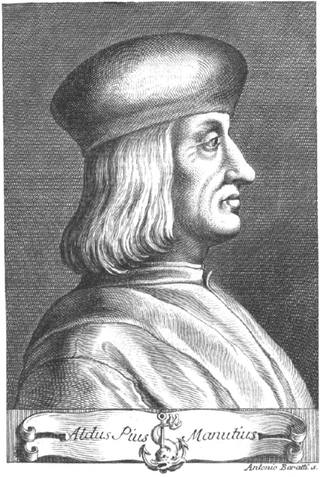
Discordianism is a belief system based around Eris, the Greek goddess of strife and discord, and variously defined as a religion, new religious movement, virtual religion, or act of social commentary; though prior to 2005, some sources categorized it as a parody religion. It was founded after the 1963 publication of its holy book, Principia Discordia, written by Greg Hill with Kerry Wendell Thornley, the two working under the pseudonyms Malaclypse the Younger and Omar Khayyam Ravenhurst.

Desiderius Erasmus Roterodamus, commonly known in English as Erasmus of Rotterdam or simply Erasmus, was a Dutch Christian humanist, Catholic priest and theologian, educationalist, satirist, and philosopher. Through his vast number of translations, books, essays, prayers and letters, he is considered one of the most influential thinkers of the Northern Renaissance and one of the major figures of Dutch and Western culture.

Aldus Pius Manutius was an Italian printer and humanist who founded the Aldine Press. Manutius devoted the later part of his life to publishing and disseminating rare texts. His interest in and preservation of Greek manuscripts mark him as an innovative publisher of his age dedicated to the editions he produced. Aldus Manutius introduced the small portable book format with his enchiridia, which revolutionized personal reading and are the predecessor of the modern paperback book. He also helped to standardize use of punctuation including the comma and the semicolon.

Festina is a Spanish watch conglomerate. In 1985, businessman Miguel Rodríguez acquired Festina, a brand founded in Switzerland in 1902, thus forming the Festina-Lotus Group.
Johann Caspar Ferdinand Fischer was a German Baroque composer. Johann Nikolaus Forkel ranked Fischer as one of the best composers for keyboard of his day; however, partly due to the rarity of surviving copies of his music, his music is rarely heard today.

The 1998 Tour de France was the 85th edition of the Tour de France, one of cycling's Grand Tours. The 3,875 km (2,408 mi) race was composed of 21 stages and a prologue. It started on 11 July in Ireland before taking an anti-clockwise route through France to finish in Paris on 2 August. Marco Pantani of Mercatone Uno–Bianchi won the overall general classification, with Team Telekom's Jan Ullrich, the defending champion, and Cofidis rider Bobby Julich finishing on the podium in second and third respectively.

In Greek mythology, the Apple of Discord was a golden apple dropped by Eris, the goddess of strife, at the wedding of Peleus and Thetis. It sparked a vanity-fueled dispute among Hera, Athena, and Aphrodite that led to the Judgement of Paris and ultimately the Trojan War.

Camillo Sitte was an Austrian architect, painter and urban theorist whose work influenced urban planning and land use regulation. Today, Sitte is best remembered for his 1889 book, City Planning According to Artistic Principles, in which he examined and documented the traditional, incremental approach to urbanism in Europe, with a close focus on public spaces in Italy and the Germanic countries.

The Hong Kong Golf Club is a private golf club. It is home to the Hong Kong Open, a tournament co-sanctioned by the European and Asian Tours.
The Festina affair was a series of doping scandals within the sport of professional cycling that occurred during and after the 1998 Tour de France. The affair began when a large haul of doping products was found in a support car belonging to the Festina cycling team just before the start of the race. A resulting investigation revealed systematic doping involving many teams in the Tour de France. Hotels where teams were staying were raided and searched by police, confessions were made by several retired and current riders, and team personnel were arrested or detained. Several teams withdrew completely from the race.

Coppia ferrarese, also known as ciopa, ciupeta and pane ferrarese, is a type of sourdough bread made with flour, lard, malt, and olive oil, and has a twisted shape. It was first made around the thirteenth century in the Italian province of Ferrara. It has protected geographical indication (PGI) in the European Union status under European Union law, which was obtained in 2001.

The Principia Discordia is the first published Discordian religious text. It was written by Greg Hill with Kerry Wendell Thornley and others. The first edition was printed using Jim Garrison's Xerox printer in 1963. The second edition was published under the title Principia Discordia or How The West Was Lost in a limited edition of five copies in 1965. The phrase Principia Discordia, reminiscent of Isaac Newton's 1687 Principia Mathematica, is presumably intended to mean Discordant Principles, or Principles of Discordance.

Benedict Anton Aufschnaiter was an Austrian Baroque composer.

Festina lente or speûde bradéōs is a classical adage and oxymoron meaning "make haste slowly". It has been adopted as a motto numerous times, particularly by the emperors Augustus and Titus, then later by the Medicis and the Onslows.

The Davis Museum is an art museum located on the Wellesley College campus in Wellesley, Massachusetts. The college art collection was first displayed in the Farnsworth Art Building, founded in 1889. The museum in its present form opened in 1993 in a building designed by Rafael Moneo.
Festina lente is a 1986 composition by Estonian composer Arvo Pärt. It is scored for string orchestra and harp. It uses layering to explore the musical ideas, by allowing the violas to take the melody, the violins to take it at double the speed and the basses to take the melody at half time.
Demiak is a Dutch painter, photographer and sculptor. Born in 1967 in Goudriaan, he lives and works in The Hague.













